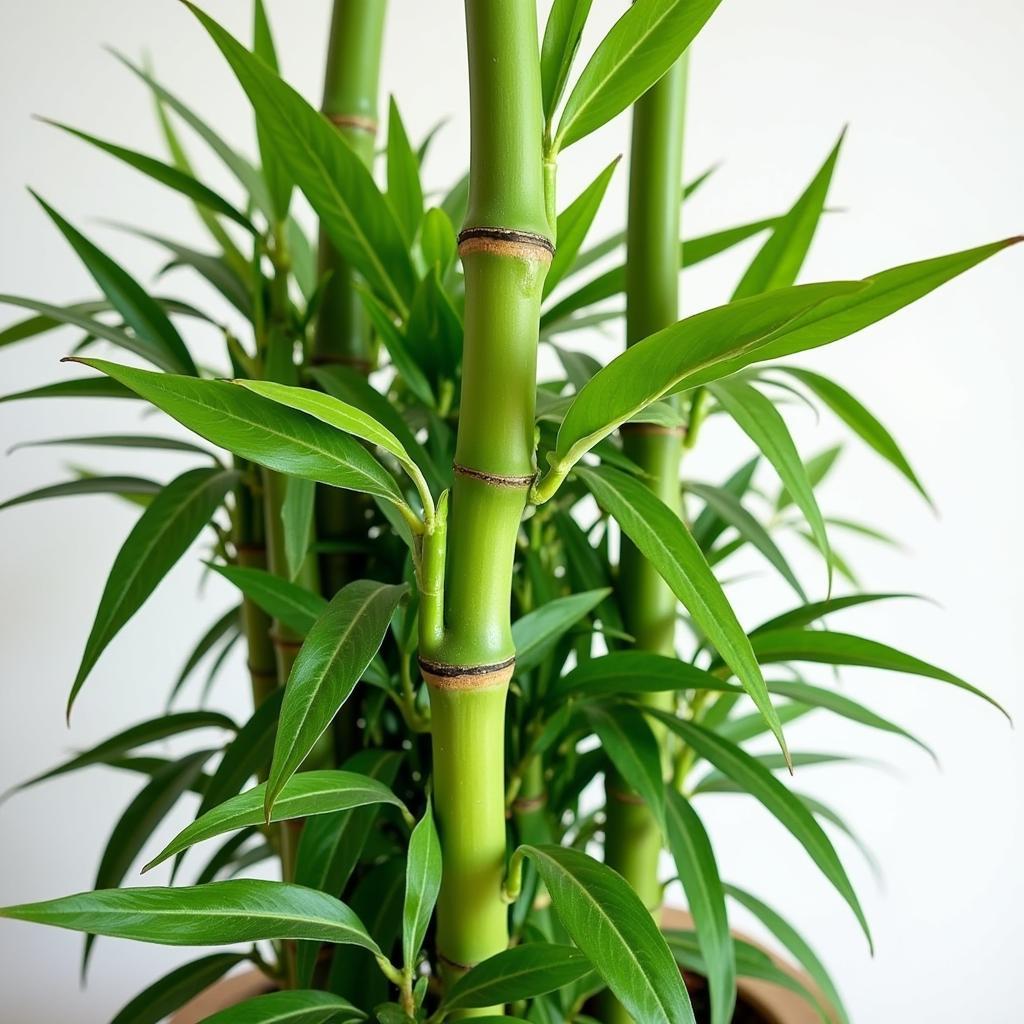Lucky bamboo is a popular houseplant believed to bring good fortune and positive energy into homes and businesses. Despite its name, lucky bamboo isn’t actually bamboo but a type of dracaena plant native to Southeast Asia. Known for its resilience and adaptability, this plant thrives indoors with minimal care, making it an excellent choice for beginners and experienced plant parents alike. This comprehensive guide will delve into the essentials of lucky bamboo plant care, equipping you with the knowledge to help your plant thrive and bring you years of joy.
Understanding Your Lucky Bamboo
Before diving into care tips, it’s crucial to understand the unique characteristics of lucky bamboo. This plant can grow in soil or water, with each method requiring specific care practices. Whether you receive a lucky bamboo arrangement as a gift or purchase one, identifying its growing medium is the first step towards providing appropriate care.
Lucky Bamboo Plant Care in Water
Growing lucky bamboo in water is a popular choice due to its aesthetic appeal and ease of maintenance. Here’s a step-by-step guide to caring for your water-grown lucky bamboo:
-
Choosing the Right Container: Select a container that complements your plant’s size and your home décor. Ensure the container has sufficient depth to accommodate the plant’s roots and provide stability.
-
Using the Right Water: Lucky bamboo is sensitive to chemicals commonly found in tap water, such as chlorine and fluoride. To prevent these chemicals from harming your plant, use filtered water or let tap water sit out for 24 hours to allow the chemicals to dissipate.
-
Water Level and Changes: Maintain a water level that covers the plant’s roots entirely, typically about 1-2 inches. Change the water every 1-2 weeks to prevent stagnation and the buildup of harmful bacteria.
-
Fertilizing: While lucky bamboo can survive solely on water, providing occasional fertilization can enhance its growth and vibrancy. Use a diluted liquid fertilizer specifically formulated for lucky bamboo or water-grown plants.
-
Providing Adequate Light: Lucky bamboo thrives in bright, indirect sunlight. Avoid placing your plant in direct sunlight, as this can scorch its leaves.
Lucky Bamboo Plant Care in Soil
While less common, growing lucky bamboo in soil offers a stable environment and can be less demanding in terms of water changes. Here’s how to care for your soil-grown lucky bamboo:
-
Selecting the Right Soil: Choose a well-draining potting mix that retains moisture without becoming waterlogged. A blend formulated for palms or dracaenas works well.
-
Watering: Water your lucky bamboo thoroughly when the top inch of soil feels dry to the touch. Avoid overwatering, as this can lead to root rot.
-
Fertilizing: Similar to water-grown lucky bamboo, fertilize your soil-grown plant every 4-6 weeks during the growing season (spring and summer) with a balanced, water-soluble fertilizer.
-
Providing Optimal Lighting: The same lighting requirements apply to both water and soil-grown lucky bamboo. Place your plant in a location that receives bright, indirect sunlight.
Common Problems and Solutions
While lucky bamboo is relatively low-maintenance, it can occasionally encounter issues. Here are some common problems and their solutions:
- Yellowing Leaves: This is often a sign of overwatering, excessive sunlight, or using tap water containing high levels of chemicals.
- Brown Leaf Tips: Dry air, underwatering, or inadequate humidity can cause brown leaf tips.
- Algae Growth in Water: Algae thrive in sunlight. To prevent algae growth, use an opaque container or change the water more frequently.
 Vibrant Green Lucky Bamboo Plant
Vibrant Green Lucky Bamboo Plant
Frequently Asked Questions about Lucky Bamboo Plant Care
1. How often should I water my lucky bamboo plant?
The frequency of watering depends on whether your lucky bamboo is grown in water or soil. For water-grown plants, change the water every 1-2 weeks. For soil-grown plants, water when the top inch of soil feels dry.
2. Can I use tap water for my lucky bamboo?
It’s best to use filtered water or let tap water sit out for 24 hours before using it for your lucky bamboo. This allows harmful chemicals to evaporate.
3. How much light does my lucky bamboo need?
Lucky bamboo thrives in bright, indirect sunlight. Avoid placing it in direct sunlight to prevent leaf burn.
4. How do I propagate my lucky bamboo plant?
You can propagate lucky bamboo by cutting off a stalk just above a growth node and placing it in water or moist soil.
5. Why are the leaves on my lucky bamboo turning yellow?
Yellowing leaves can indicate overwatering, excessive sunlight, or the use of tap water containing harmful chemicals.
6. How can I prevent algae growth in my water-grown lucky bamboo?
Use an opaque container or change the water more frequently to prevent algae growth.
7. Is lucky bamboo toxic to pets?
Yes, lucky bamboo can be mildly toxic to pets if ingested. Keep it out of reach of curious animals.
Conclusion
Lucky bamboo is an excellent low-maintenance plant that can thrive in various indoor environments. By following these care tips, you can enjoy the beauty and positive energy this plant brings for years to come. Remember to observe your plant closely, address any issues promptly, and provide the optimal conditions for its growth and well-being.


